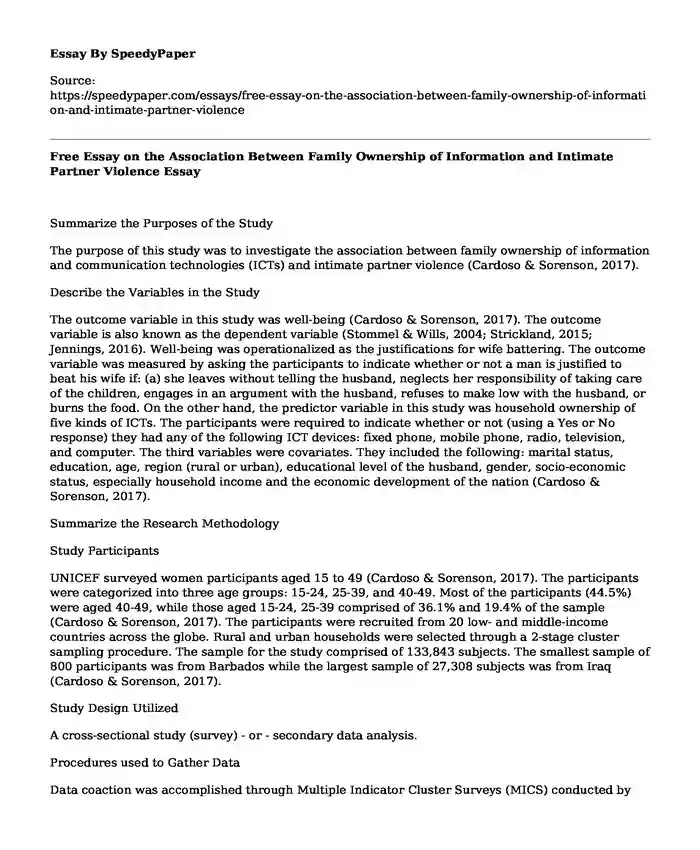
| Type of paper: | Problem solving |
| Categories: | Information technologies Domestic violence |
| Pages: | 3 |
| Wordcount: | 613 words |
Summarize the Purposes of the Study
The purpose of this study was to investigate the association between family ownership of information and communication technologies (ICTs) and intimate partner violence (Cardoso & Sorenson, 2017).
Describe the Variables in the Study
The outcome variable in this study was well-being (Cardoso & Sorenson, 2017). The outcome variable is also known as the dependent variable (Stommel & Wills, 2004; Strickland, 2015; Jennings, 2016). Well-being was operationalized as the justifications for wife battering. The outcome variable was measured by asking the participants to indicate whether or not a man is justified to beat his wife if: (a) she leaves without telling the husband, neglects her responsibility of taking care of the children, engages in an argument with the husband, refuses to make low with the husband, or burns the food. On the other hand, the predictor variable in this study was household ownership of five kinds of ICTs. The participants were required to indicate whether or not (using a Yes or No response) they had any of the following ICT devices: fixed phone, mobile phone, radio, television, and computer. The third variables were covariates. They included the following: marital status, education, age, region (rural or urban), educational level of the husband, gender, socio-economic status, especially household income and the economic development of the nation (Cardoso & Sorenson, 2017).
Summarize the Research Methodology
Study Participants
UNICEF surveyed women participants aged 15 to 49 (Cardoso & Sorenson, 2017). The participants were categorized into three age groups: 15-24, 25-39, and 40-49. Most of the participants (44.5%) were aged 40-49, while those aged 15-24, 25-39 comprised of 36.1% and 19.4% of the sample (Cardoso & Sorenson, 2017). The participants were recruited from 20 low- and middle-income countries across the globe. Rural and urban households were selected through a 2-stage cluster sampling procedure. The sample for the study comprised of 133,843 subjects. The smallest sample of 800 participants was from Barbados while the largest sample of 27,308 subjects was from Iraq (Cardoso & Sorenson, 2017).
Study Design Utilized
A cross-sectional study (survey) - or - secondary data analysis.
Procedures used to Gather Data
Data coaction was accomplished through Multiple Indicator Cluster Surveys (MICS) conducted by UNICEF. The MICS are household surveys undertaken in low-income and middle-income counties across the world. The surveys are large and nationally representative. MICS surveys were conducted with the aim of monitoring the progress towards the realization of women and children's Millennium Development Goals. The MICS household survey covered a range of topics including demographics, health, and well-being topics. Rural and urban households were selected through a 2-stage cluster sampling procedure.
Statistical Analysis
Descriptive statistics were used to understand the sample's independent variables as well as the rejection of common justifications for wife battering. The main descriptive statistics used to describe the sample's socio-demographic variables was the percentages. Apart from descriptive statistics, the authors analyzed the data using inferential statistical analysis. For instance, Pearson's chi-square test was used to examine the differences among covariates associated with the rejection of common wife-beating justifications. A correlation matrix was used to test for multicollinearity. Additionally, logistic regression analysis was used to predict whether the participants will reject all the five common reasons given for wife beating. Moreover, multivariate logistic regression was used to determine whether there is a relationship between the dependent variables and the main indicator variables (Cardoso & Sorenson, 2017).
References
Cardoso, L. F., & Sorenson, S. B. (2017). Violence against women and household ownership of radios, computers, and phones in 20 countries. American journal of public health, 107(7), 1175-1181.
Jennings, W. G. (Ed.). (2016). The encyclopedia of crime and punishment. John Wiley & Sons.
Stommel, M., & Wills, C. (2004). Clinical research: Concepts and principles for advanced practice nurses. Lippincott Williams & Wilkins.
Strickland, J. (2015). Operations Research Using Open-Source Tools. Lulu.com.
Cite this page
Free Essay on the Association Between Family Ownership of Information and Intimate Partner Violence. (2022, Mar 30). Retrieved from https://speedypaper.net/essays/free-essay-on-the-association-between-family-ownership-of-information-and-intimate-partner-violence
Request Removal
If you are the original author of this essay and no longer wish to have it published on the SpeedyPaper website, please click below to request its removal:
- Essay Example on an Explanation of the Differential Diagnosis for the Patient
- Crisis in Criminal Justice System - Free Essay for Everyone
- Free Essay on Small Restaurant Growth and Development
- Essay Sample: English Literature Lesson
- Essay Sample Focusing on the Future of Tourism in Hawaii
- Essay Example on the Importance of Setting Performance Expectations
- Essay Sample: A Comprehensive Appraisal of the Evidence-Based Practices in Nursing
Popular categories




